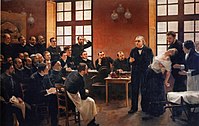
Photo from wikipedia
Conversion disorder, also called Functional Neurological Symptom Disorder is poorly understood by many in the medical profession and is associated with considerable health care costs. Sigmund Freud, in an early,… Click to show full abstract
Conversion disorder, also called Functional Neurological Symptom Disorder is poorly understood by many in the medical profession and is associated with considerable health care costs. Sigmund Freud, in an early, pre-psychoanalytic period paper, suggested that hysterical motor paralyses arose from a "functional or dynamic lesion" which was no different from an organic one, but rather an altered expression of it. He linked this functional brain disturbance to an excess of affect, a faulty conceptualization on the part of the symptomatic individual of how the affected organ works, and elements of dissociation and dual consciousness. One hundred and thirty years later converging functional imaging studies provide support for the excess affect component of his hypothesis. A small but growing fMRI literature has revealed bottom-up hyperactive neural activity in limbic regions and a potential failure of top-down regulation from prefrontal regions. Aberrant functional connectivity of limbic-motor regions now provides a mechanistic model that sheds light on an early Freudian theory explaining, in part, how symptoms of Conversion Disorder arise.
Journal Title: Journal of psychiatric research
Year Published: 2021
Link to full text (if available)
Share on Social Media: Sign Up to like & get
recommendations!